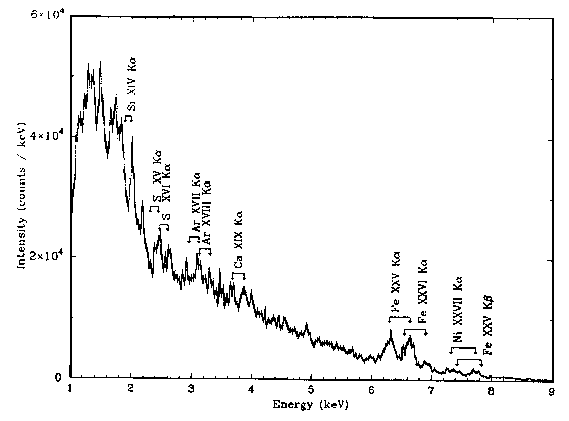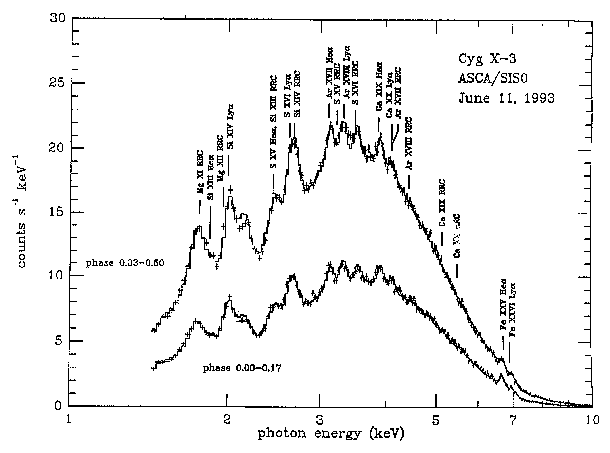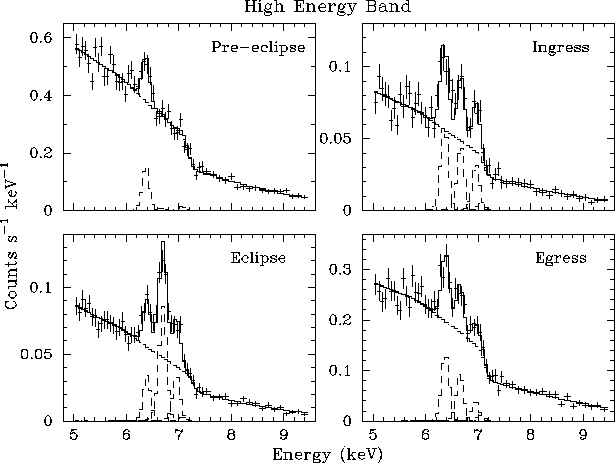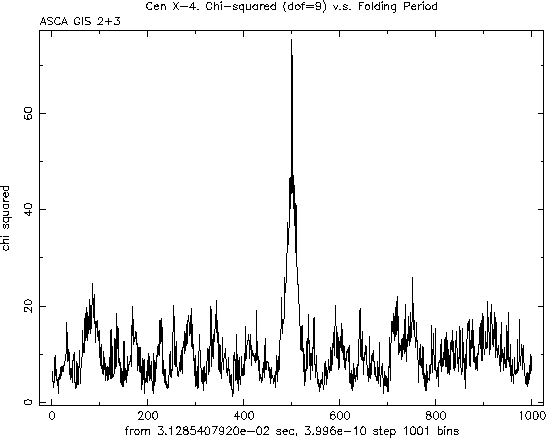X-ray Binaries
SS433 and Super-luminal Jet Sources
SS433 is an extraordinary X-ray binary which is ejecting bipolar jets with 26 % of the velocity of light. Previous observations with lower energy resolution detected prominent iron emission lines at ~ 7 keV, but spectral fine structure could not be resolved. ASCA SIS observations of SS433 resolved, for the first time, the blue-shifted emission lines, from the approaching jet, and the red-shifted emission lines, from the receding jet (Kotani et al. 1994; Figure 14). K-alpha emission lines of helium-like and hydrogenic Si, S, Ar, Ca Fe, Ni were detected, and each line was separated into the blue and red-shifted components. It is now possible to determine the dynamical parameters of the jets from X-ray observations by precisely measuring the line energy shifts.

Figure 14. The SIS energy spectrum of SS433 observed on 1993 April 23. Line identifications are indicated for each pair of blue-shifted and red-shifted lines. The figure was taken from Kotani et al. 1994.
In 1994 super-luminal motion was observed for the first time from Galactic sources. Radio observations revealed the velocities of the jets in GRS1915+105 and GRO J1655-40 to be ~ 0.92c. Curiously enough, these super-luminal jet sources do not show emission lines like SS433. Instead, unique absorption line features were detected at ~ 7 keV and ~ 8 keV which have never been observed from other kinds of X-ray binaries (figure 15). These absorption features, probably corresponding to K-alpha and K-beta lines from helium-like and hydrogenic iron, are weak (EW <~ 40 eV), and would not have been detected with instruments having a lower energy resolution than the ASCA SIS. The relation of these absorption lines to the relativistic jets is not understood.

In 1994 super-luminal motion was observed for the first time from Galactic sources. Radio observations revealed the velocities of the jets in GRS1915+105 and GRO J1655-40 to be ~ 0.92c. Curiously enough, these super-luminal jet sources do not show emission lines like SS433. Instead, unique absorption line features were detected at ~ 7 keV and ~ 8 keV which have never been observed from other kinds of X-ray binaries (figure 15). These absorption features, probably corresponding to K-alpha and K-beta lines from helium-like and hydrogenic iron, are weak (EW <~ 40 eV), and would not have been detected with instruments having a lower energy resolution than the ASCA SIS. The relation of these absorption lines to the relativistic jets is not understood.


Figure 15. SIS energy spectra of GRS1915+105 (left) and GRO J1655-40 (right) in the iron energy band. Ratios of the energy spectra to smooth model functions are shown. An intensity dip was observed from GRO J1655-40 , and the dip spectrum is consistent with a neutral iron edge absorption at 7.11 keV. Other spectra indicate absorption line features. The figure was taken from Ebisawa (1996).
Photo-ionized Plasmas
In bright X-ray binaries strong X-ray emission can photoionize circumstellar material from the companion leading to numerous emission lines. Liedahl & Paerels (1996 ApJ submitted) have shown that the SIS spectrum of Cyg X-3 must be modelled by including narrow recombination continuum emission (figure 16). This is the first detection of such features and immediately confirms that X-ray photionization produces extreme overionization in the circumsource medium, and that the X-ray emission features are energized by the hard X-ray continuum.

Figure 16. SIS energy spectra of Cyg X-3 showing the presence of narrow radiative recombination continuum (RRC) features.
Studying the emission lines of X-ray binaries can constrain the abundance of elements in the system leading to constraints on binary evolution. The X-ray pulsar 4U1626-67 exhibited an emission-line complex centered on 1 keV (Angelini 1994; Figure 17). The strongest line is identified with hydrogenic Ne Ly-alpha at 1.008 keV. The strength of the neon emission compared to the expected iron L complex in the same energy band implies a large neon overabundance relative to iron. Although a hydrogen burning companion star was once suggested to explain the X-ray and optical characteristics of this source, the recent discovery of the neon overabundance strongly suggests that the companion star is burning or has burned helium, since neon is a by-product of helium burning. 4U1626-67 is an unusual X-ray pulsar because it is one of the few X-ray pulsars having a low mass companion. If the 4U1626-67 mass donor fills its Roche lobe, the helium burning companion mass is required to be ~ 0.8 Solar masses (Levine et al. 1988); such a massive companion gives an optical luminosity and mass accretion rate which are incompatible with optical observations and X-ray luminosities. A plausible model is that the He-burning companion does not fill its Roche lobe and the mass transfer is driven by a stellar wind. This allows a less massive and less luminous companion star. Low energy line emission has been detected by ASCA from a number of LMXRB, with several different patterns emerging. The strong neon line emission seen from 4U1626-67 is clearly the exception. In most LMXRB either Fe L emission at 1 keV dominates (e.g. in Cyg X-2) or OVIII emission around 0.7 keV (Angelini et al 1996 in preparation). These different patterns seem to reflect an underlying fundamental difference in the abundance of the companion star.

Figure 17. SIS energy spectrum of 4U1626-67. Upper panel shows the phase average spectra fitted with a blackbody plus a power-law model, and the lower panels shows the residuals. The strong Ne Ly-alpha line at ~ 1.0 keV is conspicuous. The figure was taken from Angelini et al. (1995).
Eclipses
Some X-ray binaries show orbital eclipses. Since direct emission from the neutron star is completely blocked during the eclipse, orbital eclipses can provide ideal laboratories to study extended circumstellar matter around neutron stars. Furthermore, by studying spectral variations over the eclipse, we can probe the spatial structure of the circumstellar matter. Orbital eclipses of Vela X-1 and Cen X-3 were observed, and spectral variations were studied as a function of orbital phases (Figure 18, Nagase et al. 1994 ApJ 436, L1 for Vela X-1; Figure 19, Ebisawa et al. 1996 for Cen X-3). Both sources show numerous emission lines from highly ionized circumstellar matter during the eclipses. Comparing line energies from the two sources, emission lines from Vela X-1 are mostly from helium-like ions of heavy elements, whereas lines from Cen X-3 are mostly from hydrogenic ions. The difference in the ionization states is considered to reflect the difference in the luminosities of the two sources; ~ 10^37 erg/s for Vela X-1 and ~ 10^38 erg/s for Cen X-3. As well as the emission lines from highly ionized iron ions at 6.67 keV (from Fe^+25) and 6.97 keV (from Fe^+26), 6.4 keV iron lines, from neutral or weakly ionized iron, are observed from both sources (Figure 18 and 19). The SIS energy resolution allows intensity variations of these three iron emission lines to be determined individually as a function of the orbital phase. For Vela X-1, the 6.4 keV equivalent-width dramatically increases during the eclipse (figure 18), indicating the 6.4 keV line emission region is more extended than the companion star. For Cen X-3, on the contrary, the 6.4 keV line equivalent width was hardly variable (figure 19), indicating that the 6.4 keV line emission region is close to the neutron star. Relative to the 6.4 keV line intensity, 6.67 and 6.97 keV line intensities of Cen X-3 become most significant during the eclipse. This clearly indicates the highly photoionized plasma is more extended than the companion star.

Figure 18. Energy spectra of Vela X-1 from SIS at post-eclipse (top), pre-eclipse (middle), and eclipse (bottom) phases. Note that the ordinates of the top two panels are on logarithmic scales, whereas that of the bottom panel is on a linear scale to clearly show the emission line features. The figure was taken from Nagase et al. (1994).



Figure 19. SIS energy spectra of Cen X-3 in the high-energy band (5 - 10 keV) and the low energy band (0.8 - 4 keV) for the pre-eclipse, ingress, eclipse and the egress period. The figure was taken from Ebisawa et al. (1996).
Novae in Quiescent States
Hard X-ray studies of the quiescent state of binary transient sources has become possible for the first time with ASCA. The neutron star binary transients X1608-52 and Cen X-4 were observed in the quiescent state at X-ray luminosities of 10^32-33 ergs/s (Asai et al. 1996). Both sources were shown to have blackbody temperatures of 0.2-0.3 keV and emission regions of size ~ 10 km^2 (figure 20). In addition, Cen X-4 was detected above ~ 2 keV. During nova outbursts with luminosities of 10^36-37 ergs/s the 2-10 keV spectra can be modelled as power-laws with indices 1.5-2.0 (Mitsuda et al. 1989 PASJ 41, 97; Yoshida et al. 1993 PASJ 405, 605; Penninx et al. 1989 A&Ap 208, 146). This is considered to be due to Compton up-scattering of soft photons from the neutron star surface. The present results suggest that the emission mechanism in these transient sources change drastically when the luminosities go down to 10^32-33 ergs/s .

Figure 20. Energy spectra of X1608-52 (upper panels) and Cen X-4 (lower panels) obtained with the SIS (left) and GIS (right). The model spectra show a blackbody for X11608-52 and a blackbody plus a power-law for Cen X-4. The figure was taken from Asai et al. 1996.
It is widely believed that neutron star binaries with low mass companions (low mass X-ray binaries; LMXB) are progenitors of millisecond radio pulsars. Thus the neutron stars in LMXBs are expected to be rapidly rotating and the X-ray emission to show coherent pulsations. Although previous searches for coherent pulsations from bright LMXB were not successful (e.g., Wood et al. 1991 ApJ 379, 295; Vaughan et al. 1994 ApJ 421, 738), the first coherent pulsations from LMXB are strongly suggested (at 95 % significance) from the quiescent state of Cen X-4 (Mitsuda et al. 1996 Waseda meeting; Figure 21). A pulsation search from such a dim source requires both high signal to noise ratio and high time resolution, which are unique capabilities of ASCA. As well as the coherent pulsation detected at 31.3 msec, the projected semi-major axis (a_x sin i) was tightly constrained, and, assuming that the mass of the neutron star is 1.4 Solar masses, inclination angle and companion mass were determined to be 35-41 deg and 4.1 - 5.0 Solar masses, respectively. These orbital parameters are consistent with optical observations. This detection of the coherent pulsation from Cen X-4 will have two impacts on the study of LMXB. First, we now know that orbital parameters of LMXB, as well as the companion mass, can be precisely determined from X-ray observations through timing analysis. Secondly, the pulsar in Cen X-4 is the fastest accretion-powered pulsar known, with period comparable to those of millisecond radio pulsars; hence the standard scenario for the evolution of neutron star binaries is strengthened.
It is widely believed that neutron star binaries with low mass companions (low mass X-ray binaries; LMXB) are progenitors of millisecond radio pulsars. Thus the neutron stars in LMXBs are expected to be rapidly rotating and the X-ray emission to show coherent pulsations. Although previous searches for coherent pulsations from bright LMXB were not successful (e.g., Wood et al. 1991 ApJ 379, 295; Vaughan et al. 1994 ApJ 421, 738), the first coherent pulsations from LMXB are strongly suggested (at 95 % significance) from the quiescent state of Cen X-4 (Mitsuda et al. 1996 Waseda meeting; Figure 21). A pulsation search from such a dim source requires both high signal to noise ratio and high time resolution, which are unique capabilities of ASCA. As well as the coherent pulsation detected at 31.3 msec, the projected semi-major axis (a_x sin i) was tightly constrained, and, assuming that the mass of the neutron star is 1.4 Solar masses, inclination angle and companion mass were determined to be 35-41 deg and 4.1 - 5.0 Solar masses, respectively. These orbital parameters are consistent with optical observations. This detection of the coherent pulsation from Cen X-4 will have two impacts on the study of LMXB. First, we now know that orbital parameters of LMXB, as well as the companion mass, can be precisely determined from X-ray observations through timing analysis. Secondly, the pulsar in Cen X-4 is the fastest accretion-powered pulsar known, with period comparable to those of millisecond radio pulsars; hence the standard scenario for the evolution of neutron star binaries is strengthened.

Figure 21. Chi^2 of the folded light curve of Cen X-4 GIS data as a function of trial folding periods. The best spin-period 31.28560792 +/-0.00000012 msec. The figure was taken from Mitsuda et al. (1996).
Last modified: Tuesday, 26-Jun-2001 14:22:33 EDT
If you have any questions concerning ASCA, visit our Feedback form.

